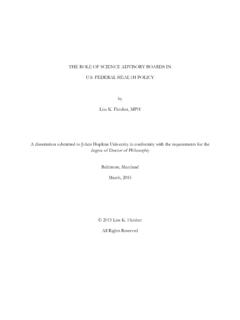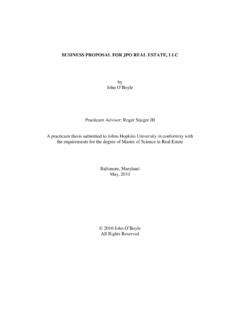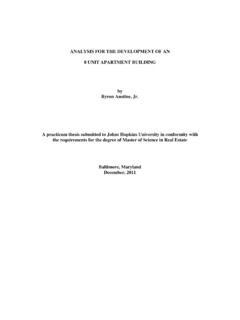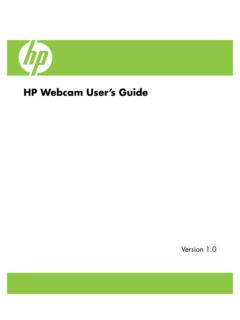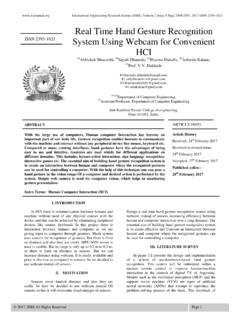Transcription of iıSeeYou: Disabling the MacBook Webcam Indicator LED
1 I SeeYou: Disabling the MacBookWebcam Indicator LEDM atthew BrockerJohns Hopkins UniversityStephen CheckowayJohns Hopkins UniversityAbstract The ubiquitous Webcam Indicator LED is an im-portant privacy feature which provides a visual cue that thecamera is turned on. We describe how to disable the LED ona class of Apple internal iSight webcams used in some versionsof MacBook laptops and iMac desktops. This enables video tobe captured without any visual indication to the user and canbe accomplished entirely in user space by an unprivileged (non-root) same technique that allows us to disable the LED, namelyreprogramming the firmware that runs on the iSight, enablesa virtual machine escape whereby malware running inside avirtual machine reprograms the camera to act as a USB HumanInterface Device (HID) keyboard which executes code in the hostoperating build two proofs-of-concept: (1) an OS X application,iSeeYou, which demonstrates capturing video with the LEDdisabled; and (2) a virtual machine escape that runs shell commands.
2 To defend againstthese and related threats, we build an OS X kernel extension,iSightDefender, which prohibits the modification of the iSight sfirmware from user INTRODUCTIONAt the beginning of the 2008 school year, the Lower MerionSchool District provided a MacBook laptop to each enrolledstudent. These laptops came pre-loaded with theLANrevremote administration tool (RAT) which allowed school districtofficials to, among other things, capture images from theMacBooks built-in iSight Webcam . During the following 18months, officials captured more than 30 thousand images fromthese webcams [5,6]. The first indication that images werebeing captured was every time the software took a picture, thegreen Indicator LED would briefly illuminate [5,6,40]. Someteachers were so concerned by this they they covered the lensof the webcams on their own laptops [6]. Here, the indicatorLED worked exactly as it was supposed to and alerted theusers that they were being possibility that a Webcam could be capturing pictureswithout the LED illuminating has led to suggestions thatowners should tape over the Webcam [41] as well as productsdesigned to cover the camera such as stickers [10] and theamusingly named iPatch [53].
3 This incident illustrates the dangers of passive sensors likecameras and microphones. Unlike active input devices likekeyboards and mice that require user actions to provide input,a passive sensor requires no action on the part of the user tocapture input. Indeed, a user is typically unaware that input isbeing captured at all unless specific mechanisms are built into(a) Image sensor (front)(b) Image sensor (back)(c) Main board (front)(d) Main board (back)Fig. 1: The iSight from a 2008 MacBook we technology to indicate that the sensor is currently in mechanisms include camera-use Indicator LEDs, shuttersounds on cell phone cameras, and GPS-use Indicator iconson mobile devices and the past few years, the ever-expanding set of sensorspresent in commodity laptops and smart phones has promptedthe security and privacy community to begin researching waysto detect and limit the undesired use of sensors [20,22,24,25,29].
4 At the same time, researchers have demonstrated attacksexploiting the presence of sensors such as a clickjackingattacks against Adobe Flash to gain access to the camera andmicrophone [23] from a malicious web page and exfiltratingaudio from microphones in modern automobiles [11]. (SeeSection II for more examples.)Our results in this paper demonstrate that, at least in somecases, people have been correct to worry about malwarecovertly capturing images and video. We show a vulnerabilityin the iSight Webcam that affects a particular range of Applecomputers including the MacBooks given to the studentsin the Lower Merion School District that can be exploitedto turn on the camera and capture images and video withoutthe Indicator a high level, our investigation of the iSight revealedthat it is designed around a microprocessor and a separateimage sensor with an Indicator LED sitting between them suchthat whenever the image sensor is transmitting images to themicrocontroller, a hardware interlock illuminates the LED.
5 Weshow how to reprogram the microcontroller with arbitrary, newfirmware. This in turn enables us to reconfigure the imagesensor, allowing us to bypass the hardware interlock anddisable the LED. We also show a new method of performinga virtual machine escape based on our ability to reprogramthe , our technical contributions in this paper arefive-fold:1)We describe the architecture of the Apple internal iSightwebcam found in previous generation Apple productsincluding the iMac G5 and early Intel-based iMacs,MacBooks, and MacBook Pros until roughly 2008(Section III).2)We demonstrate how to bypass the hardware interlock thatthe iSight uses to turn on the Indicator LED wheneverthe camera is capturing images or video (Section IV)and provide a proof-of-concept user space application,iSeeYou, to do so (Section V).3)We demonstrate how to use the capability developedto bypass the hardware interlock to achieve a virtualmachine escape (Section VI).
6 4)We develop an OS X kernel extension,iSightDefender,to defend against these attacks (Section VII).5)We sketch the design space for building a secure cameramodule (Section VIII).The ability to bypass the interlock raises serious privacyconcerns and the technical means by which we accomplishit raises additional security concerns which we discuss inSection mount our main attack where we capturevideo without any external indication to the victim, we assumethat an attacker is able to run native code on the victim scomputer as an unprivileged user. Further, we assume the codeis unencumbered by defenses such as Apple sApp Sandbox[2]which is used for applications downloaded from the Mac AppStore but by little else. This assumption is quite mild andwould typically be satisfied by malware such as the virtual machine escape, we assume the attacker hascode running locally in the virtual machine and with whateverprivileges the guest OS requires to communicate with USBdevices.
7 We also assume that the virtual machine monitorhas exposed the iSight device to the virtual machine. Thissecond assumption is quite strong as virtual machine monitorstypically do not expose USB devices to the guest OS unlessthe user specifically configures it to do so, for example to usevideo conferencing of stress that our main result Disabling the iSight LED only applies to the first generationinternal iSight webcams and we make no claims of security orinsecurity of later models, including the most recent (renamed)FaceTime cameras. The virtual machine escape described inSection VI likely holds for other USB devices that use theCypress EZ-USB chip used in the iSight, but we have not yettested other RELATED WORKG eneral purpose computers contain a variety of processorsdesigned for performing specialized tasks other than general-purpose computation. Examples include graphics processingunits (GPUs) which produce video output; processors innetwork interface controllers (NICs) which perform networkpacket processing; microcontrollers in perhipherals such askeyboards, mice, and webcams; microcontrollers in laptopbatteries; and, in some systems, baseboard managementcontrollers (BMCs) which enables out-of-band system man-agement independent of the host computer s researchers have only recently begun examiningthese additional processors and the firmware that runs on many cases, the designers of these systems appear not tohave appreciated the security implications of their interfacesand the most well-studied processor apart from theCPU is the GPU.
8 Vasiliadis et al.[54]demonstrate usingthe GPU to harden malware against detection by using theGPU to implement unpacking and runtime et al.[31]use the GPU s direct memory access (DMA)capability to monitor the system s keyboard buffer to build akeylogger. Beyond GPU malware itself, researchers have usedthe GPU to accelerate malware detection [30] and intrusiondetection systems [46].Duflot and Perez[17]demonstrate exploiting a NIC toachieve arbitrary code execution. In follow up work, Duflotet al. [18] build a NIC malware detection [36]demonstrates how to communicate with Applelaptop batteries using the System Management Bus, authenti-cate to the battery to unseal it, and change both configurationvalues and firmware. This enables overcharging the batteryresulting in overheating and, potentially, leading to a and Wojtczuk[52]introduce the concept of a Ring 3 rootkit which runs on Intel s Active ManagementTechnology (AMT) hardware which has a processor indepen-dent of the host CPU with a separate interface to the NIC andDMA access to main a very similar vein, Farmer[21]discusses weaknessesand vulnerabilities in the Intelligent Platform ManagementInterface (IPMI) the standard interface to the baseboardmanagement controller (BMC).
9 Like AMT, a BMC has directaccess to the host system but its operation is completelyindependent making exploits both extremely powerful anddifficult to detect. Moore[39]builds on this work to producea penetration tester s guide for examining IPMI and Webcam is just a particular type of sensor attachedto a computing device. Others include microphones, ac-celerometers, and GPS sensors. Our work joins an emergingline or research on the security and privacy implications ofsuch sensors. For example, Schlegel et al.[50]show howto use a mobile phone s microphone to extract credit cardnumbers and PINs from spoken and tone-based et al.[34], Miluzzo et al.[38], Owusu et al.[43]use smartphone accelerometers to extract information aboutkey presses. Checkoway et al.[11]extract audio and GPScoordinates from automobiles. Templeman et al.[51]usesmartphone cameras to covertly take pictures which are thenused to create 3D models of physical virtual machine escape (Section VI) is not the firstto emulate a USB Human Interface Device (HID) such asa mouse or keyboard.
10 Wang and Stavrou[56]among otherthings, use a compromised smart phone to act as a USB HIDkeyboard and send key presses to the host system. Kennedyand Kelley[28]use a small microcontroller to interact withthe Windows Powershell. Pisani et al.[45]similarly describehaving USB devices pose as HID keyboards to control thecomputer. Elkins[19]adds a RF receiver for remote controllinga fake HID INTERNAL ISIGHT ARCHITECTUREThis section describes the architecture of the internal iSightwebcam in sufficient detail to understand how the multi-stepattack described in Section IV works. Readers who are alreadyfamiliar with the iSight or the Cypress EZ-USB or who are notinterested in the low-level details of the device are encouragedto skip directly to Section IV and use this section and Figure 2,in particular, as a reference as internal iSight consists of a Cypress CY7C68013 AEZ-USB FX2LP, a Micron MT9V112 CMOS digital imagesensor, a16 byteconfiguration EEPROM, and an indicatorLED (see Figure 1).
